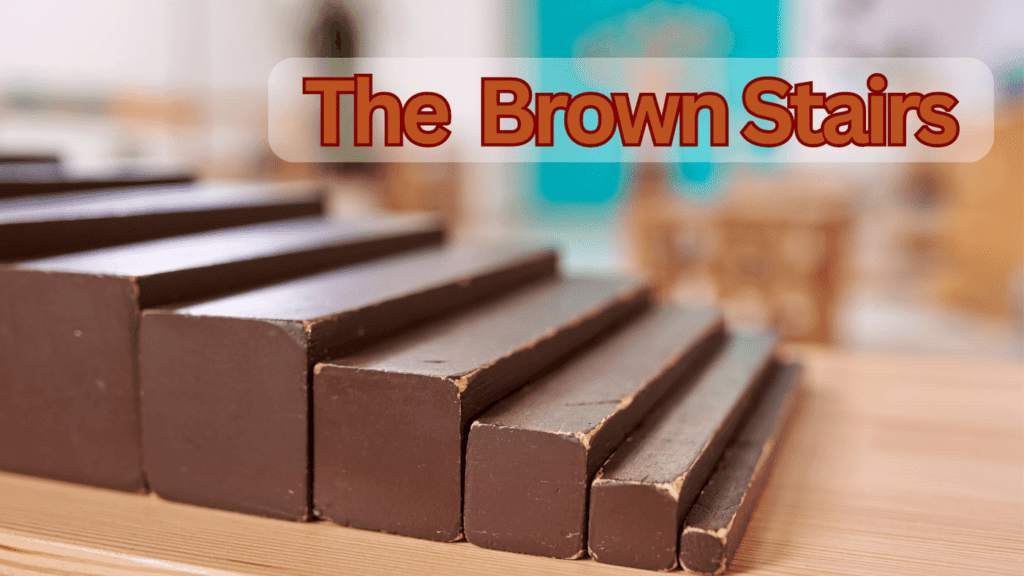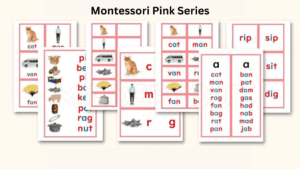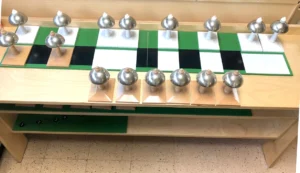The Montessori brown stairs is a sensorial lesson designed for primary level (3-6-year-old) children. Brown stairshelps them to understand the visual discrimination and develops a sense of order.
What is Montessori Brown Stairs (Broad Stairs)?
Brown Stairs or Broad Stairs is a classic sensorial material that consists of ten wooden blocks, each varying in length and width. Each stair is painted brown and perfectly fits on top of one another to form a staircase pattern starting from the longest stair at the bottom and shortest at the top.
These stairs provide a sensorial experience that aids in the development of a child’s visual discrimination, hand-eye coordination, and depth perception. As children explore the brown stairs, they engage their senses and develop a strong foundation for understanding mathematical concepts such as size, dimension, and sequencing.
Why Montessori Brown Stairs are Brown?
The Montessori brown stairs are brown because they are made from beechwood, which is a naturally brown wood. The brown color of the stairs not only adds an aesthetic appeal but also provides a sensory experience for the child. The earthy tone of the brown stairs creates a warm and inviting atmosphere, encouraging children to engage with the material and explore its different dimensions. Additionally, the brown color helps to create a sense of unity and harmony in the classroom.
What is the Key Difference Between Montessori Brown Stairs and Pink Tower?
Here are the 5 key difference when comparing Montessori sensorial materials: brown stairs and pink tower:
|
Comparision Factors |
Brown Stairs |
Pink Tower |
| Overall Purpose | Visual discrimination, dimension, and size sequencing | Size, spatial awareness, color recognition |
| Color and Appearance | Brown in Color | Pink in Color |
| Fine Motor Skills Development | Manipulation of blocks, hand-eye coordination |
Grasping and stacking skills |
| Mathematical Concepts | Size sequencing and seriation |
Volume, geometry, 3D understanding |
| Color and Shape Recognition
|
Focus on size discrimination | Incorporates color recognition |
Also Read: Pink Tower
What are the Benefits of Brown Stairs?
The Montessori brown stairs offer numerous benefits to children as they embark on their educational journey. Let’s explore some of these advantages:
- Enhancing Sensorial Development: The brown stairs stimulate a child’s senses, allowing them to explore and differentiate between various sizes and dimensions. This sensory exploration strengthens their ability to perceive and understand the world around them.
- Promoting Fine Motor Skills: As children manipulate the brown stairs, they refine their fine motor skills. The precise movements required to handle the wooden blocks contribute to the development of their hand muscles and coordination.
- Fostering Visual Discrimination: The varying sizes of the brown stairs encourage children to discern differences and similarities, refining their visual discrimination abilities. This skill is crucial for various academic subjects and everyday tasks.
- Building Mathematical Concepts: Through hands-on interaction with the brown stairs, children develop an intuitive understanding of mathematical concepts like sequencing, seriation, and size comparison. This foundational knowledge prepares them for future math-related learning.
- Encouraging Independent Exploration: The self-correcting nature of the Montessori brown stairs empowers children to explore independently and discover patterns, relationships, and concepts. This promotes a sense of autonomy and confidence in their learning journey.
How to Teach Montessori Brown Stairs to the Child?
Introducing Montessori materials, such as the brown stairs, to your child requires thoughtful consideration and guidance. Here are some practical steps to ensure a successful introduction:
- Invite the child to bring the Brown Stairs from the sensorial section to the table.
- Ask the child to put each stair on the working mat and count them.
- During the presentation, the adult uses appropriate vocabulary to describe the sizes, such as “longest,” “shortest,” and “in between,” helping the child develop a rich mathematical language.
- Once the child masters to identify the longest stair to the shortest stair, show them how to stack the stairs vertically from longest at the bottom and shortest at the top.
- Ask the child whether it looks similar to the staircase of the school/ home?
- Let the child answer yes or no.
- Help them learn its correct order, and let them explore the differences in size and dimension.
- After demonstrating, invite your child to engage with the brown stairs independently. Allow them to handle the blocks, manipulate their arrangement, and make comparisons. Observe their progress and offer gentle guidance when needed.
Tip# To maintain your child’s interest and provide continued learning opportunities, rotate the activities involving the brown stairs. Introduce new challenges, such as seriation or color sorting, to expand their understanding and keep the learning experience fresh.
5 Engaging Activities with Montessori Brown Stairs
Here are the list of 5 activities that make pink tower activity more fun:
- Size Sequencing: Guide your child to arrange the brown stairs in ascending or descending order based on size. This activity sharpens their sequencing skills and enhances their understanding of relative dimensions.
- Matching Pairs: Mix up the brown stairs and encourage your child to find matching pairs based on size. This activity strengthens their visual discrimination and fosters attention to detail.
- Sensory Sorting: Fill a container with various materials, such as sand, rice, or fabric scraps. Ask your child to explore the brown stairs and sort them based on the materials’ sensory attributes. This activity combines sensory experiences with classification skills.
- Counting Blocks: Using the brown stairs, help your child associate each block with a numerical value. Practice counting by touching each block and saying its corresponding number aloud. This activity builds early counting skills and reinforces number recognition.
- Artistic Staircase: Provide your child with art supplies, such as crayons or colored pencils, and ask them to decorate the brown stairs. Encourage them to get creative and express themselves artistically. This activity promotes fine motor skills, creativity, and personal expression.
FAQs
- What is the purpose of brown stairs in Montessori?
Brown stairs in Montessori curriculum helps develop the child’s awareness of size difference i.e. visual discrimination by providing sensorial experience. It also helps develop fine motor skills, introduce mathematical concepts, and foster independent learning in children.
- Can the brown stairs be combined with other Montessori materials?
Absolutely! The Montessori approach encourages the integration of materials to provide holistic learning experiences. Combining the brown stairs with other materials, such as color tablets or knobbed cylinders, enhances the sensorial exploration.
- Are Montessori brown stairs beneficial for children with special needs?
Montessori brown stairs can be beneficial for children with special needs as they offer tactile and visual stimulation. However, it’s essential to tailor the activities to meet the specific needs and abilities of each child.
- What is the difference between pink tower and brown stairs?
The Pink Tower in Montessori curriculum help children understand the concept of size and spatial relationships. It consists of a set of cubes that progressively increase in size following an algebraic series. In contrast, the Brown Stair is specifically used to teach children about thickness, with wooden blocks varying in width. These materials offer distinct learning experiences in the Montessori classroom.




